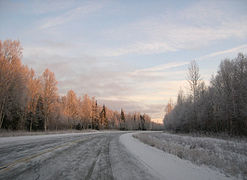
The Dwight D. Eisenhower National System of Interstate and Defense Highways, commonly known as the Interstate Highway System, is a network of controlled-access highways that forms part of the National Highway System in the United States. The system extends throughout the contiguous United States and has routes in Hawaii, Alaska, and Puerto Rico.
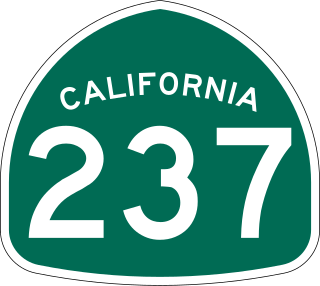
State Route 237 is a state highway in the U.S. state of California that runs from El Camino Real in Mountain View to Interstate 680 in Milpitas. Known as the Southbay Freeway for most of its length, SR 237 runs south of the San Francisco Bay, connecting the East Bay to the Peninsula.

The Richardson Highway is a highway in the U.S. state of Alaska, running 368 miles (562 km) and connecting Valdez to Fairbanks. It is marked as Alaska Route 4 from Valdez to Delta Junction and as Alaska Route 2 from there to Fairbanks. It also connects segments of Alaska Route 1 between the Glenn Highway and the Tok Cut-Off. The Richardson Highway was the first major road built in Alaska.
The Glenn Highway is a highway in the U.S. state of Alaska, extending 179 miles (288 km) from Anchorage near Merrill Field to Glennallen on the Richardson Highway. The Tok Cut-Off is often considered part of the Glenn Highway, for a total length of 328 miles (528 km).

The George Parks Highway, usually called simply the Parks Highway, runs 323 miles (520 km) from the Glenn Highway 35 miles (56 km) north of Anchorage to Fairbanks in the Alaska Interior. The highway, originally known as the Anchorage-Fairbanks Highway, was completed in 1971, and given its current name in 1975.

The Sterling Highway is a 138-mile-long (222 km) state highway in the south-central region of the U.S. state of Alaska, leading from the Seward Highway at Tern Lake Junction, 90 miles (140 km) south of Anchorage, to Homer.

The Seward Highway is a highway in the U.S. state of Alaska that extends 125 miles (201 km) from Seward to Anchorage. It was completed in 1951 and runs through the scenic Kenai Peninsula, Chugach National Forest, Turnagain Arm, and Kenai Mountains. The Seward Highway is numbered Alaska Route 9 (AK-9) for the first 37 miles (60 km) from Seward to the Sterling Highway and AK-1 for the remaining distance to Anchorage. At the junction with the Sterling Highway, AK-1 turns west towards Sterling and Homer. About eight miles (13 km) of the Seward Highway leading into Anchorage is built to freeway standards. In Anchorage, the Seward Highway terminates at an intersection with 5th Avenue, which AK-1 is routed to, and which then leads to the Glenn Highway freeway.
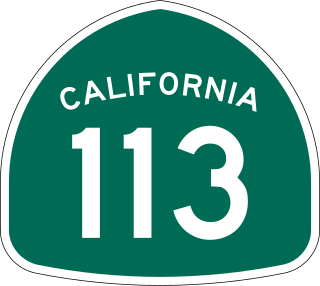
State Route 113 is a north–south state highway in the U.S. state of California that runs from around 10 miles (16 km) in the Sacramento Valley west of Rio Vista at State Route 12 to State Route 99 south of Yuba City. It serves as one of two important connecting routes between Interstate 80 and Interstate 5, bypassing Sacramento to the east; the other being Interstate 505 to the west. Past the southern terminus are Collinsville and Birds Landing around the Suisun Bay marshes. Cities along the route include Dixon, Davis, and Woodland. It also shares a stretch of Interstate 80 between just outside UC Davis and Dixon. The section running from Dixon to Woodland is a controlled-access freeway; the remainder is a standard road of two to four lanes. The freeway section spanning from the I-80 interchange in Davis to Woodland is called the Vic Fazio Highway, after the former U.S. House representative of the Davis area, who is credited with obtaining the funding for the freeway upgrade of that section.
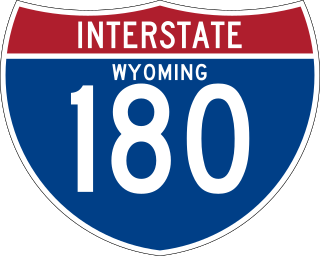
Interstate 180 (I-180) is a 1.09-mile-long (1.75 km) connector in the US state of Wyoming between I-80 and downtown Cheyenne.
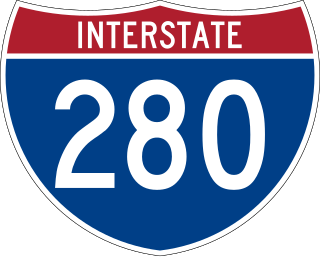
Interstate 280 (I-280) is a 12.41-mile-long (19.97 km) auxiliary Interstate Highway in Ohio that connects I-75 in northeast Toledo with I-80/I-90 southeast of the city in northeastern Wood County. Built between 1955 and 1959, the route was originally part of the Detroit–Toledo Expressway. Although first designated in 1959, the highway originally contained several at-grade intersections and other features which left it substandard to the Interstate Highway System until 1990. Further construction in 2007 built a new crossing of the Maumee River, replacing an outdated drawbridge. The highway serves as an easterly bypass of the Toledo metropolitan area, passing through the communities of Northwood and Oregon. It is one of two auxiliary Interstate Highways serving Toledo, the other being I-475.

State Route 7 is a state highway in the U.S. state of California, running from the Calexico East Port of Entry on the U.S.-Mexico border east of Calexico north to its terminus at Interstate 8 (I-8), where Orchard Road continues the route north towards Holtville. The route provides convenient access to the country of Mexico from I-8. The southern portion of the route opened in 1996, and the rest of the route connecting to I-8 opened in 2005.
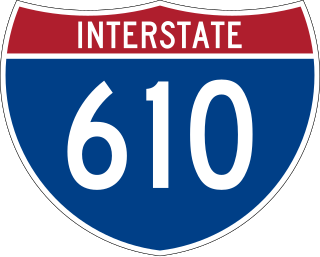
Interstate 610 (I-610) is a 4.52-mile-long (7.27 km) auxiliary route of I-10 that lies almost entirely within the city limits of New Orleans, Louisiana, bypassing its Central Business District.

State Route 198 is an east–west state highway in the U.S. state of California that runs from U.S. Route 101 south of King City to Sequoia National Park. It connects the California Central Coast to the mid–Central Valley through Hanford and Visalia, although the most developed portion is in the Central Valley itself. SR 198 intersects the major north–south routes in the Central Valley, including Interstate 5 (I-5), SR 33, and SR 99.

Interstate 44 (I-44) in the US state of Texas has a short, but regionally important, 14.77-mile (23.77 km) stretch connecting Wichita Falls with Oklahoma. Its entire length runs concurrently with U.S. Highway 277 (US 277) and US 281. I-44 provides access to downtown Wichita Falls and Sheppard Air Force Base. I-44 is known as Central Freeway in Wichita Falls and Red River Expressway in Burkburnett.

Alaska Route 1 (AK-1) is a state highway in the southern part of the U.S. state of Alaska. It runs from Homer northeast and east to Tok by way of Anchorage. It is one of two routes in Alaska to contain significant portions of freeway: the Seward Highway in south Anchorage and the Glenn Highway between Anchorage and Palmer.
The Minnesota Drive Expressway is a 7.560-mile-long (12.167 km) south–north expressway located in the city of Anchorage, Alaska, United States. The expressway includes a small portion of O'Malley Road, which is also built to expressway standards. The highway travels from the southern region of Anchorage northward to North Star neighborhood area, and bisects the community of Spenard. The first section of the highway was constructed around 1950, and the entire highway was upgraded to expressway standards by the year of 1985. The entire length of the expressway is listed on the National Highway System, a network of roads important to the country's economy, defense, and mobility.

The Hope Highway, also known as the Hope Road Turnoff, is a Forest Highway located in the Kenai Peninsula Borough, in the U.S. state of Alaska. The highway connects the city of Hope to the Seward Highway, and travels through 17 miles (27 km) of the Chugach National Forest. The road passes the ghost town of Sunrise City and several smaller settlements, remnants of the gold rush that occurred in that area. The highway was created circa 1928 and was designated as Forest Highway 14 by the Federal Highway Administration.








